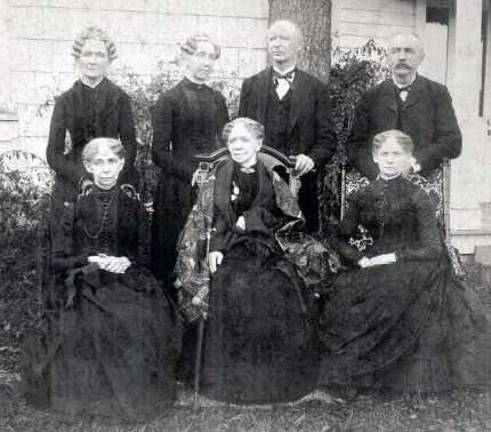My turn Jean Beattie May The legacy of the Burt family in Warwick

With the celebration of the 250th Anniversary of Warwick’s Shingle House, built by Daniel Burt in 1764, it is interesting to have a look at the impact the Burt family had on Warwick’s early history.
Pictured above in front of the Shingle House are Grinnell Burt, (far right) his brother, Thomas, and five of their seven siblings probably taken in the 1880’s. They were the great-grandchildren of Daniel and grandchildren of Daniel’s son, James Burt, a local farmer, who had served as a Lieutenant under Col. John Hathorn during the Revolution and was present at the Battle of Minisink.
James was also a member of the New York Legislature from 1797 to 1826 and served as an elector for Presidents Thomas Jefferson and William Henry Harrison.
Aptitude for the mechanical
Born in Bellvale in 1822 and orphaned at the age of 15, Grinnell Burt moved to Ohio to live with a relative, but returned to Warwick in 1841. With his aptitude for mechanical construction, he took an interest in railroad projects, while at the same time, studying and reading the law. As railroad fever began to rise in the Hudson Valley, Burt and a group of men from Warwick and Vernon organized the Warwick Valley Railroad Company in 1862, building the first line from Warwick to Chester (Greycourt) which connected with the main line of the Erie with its Newburgh branch. This resulted in Warwick farmers no longer needing to haul their milk by horse and wagon all the way to Chester.
Thanks to the use of the first refrigerated cars in America to transport fluid milk to New York, the dairy business in Warwick was instantly transformed.
Mover and shaker
Burt went on to become President and Superintendent of the Warwick Valley Railroad, the Wawayanda Railroad Company and a number of other companies that were later consolidated under the title of Lehigh and Hudson River Railway, of which he was made president and general manager. He was a mover and a shaker in the railroad industry as well as various projects for bridging the Hudson including the Storm King, Poughkeepsie and Peekskill bridges. He was active in incorporating the Village under a special charter, building Warwick’s reservoir and water works and served on the Board of Education for 32 years.
At the time of his death in 1901, special trains came from both directions bringing employees of the railroad as well as friends from all along the line and distant points. After the funeral service, more than 500 people gathered in Burt’s 18-room mansion on Maple Avenue, known as “the Arches” to pay their respects.
In 1937 the house was sold to the Sisters of the Poor of St. Francis and became the St. Anthony’s Community Hospital. Its three story brick addition opened in 1939.
Financial interests
Grinnell’s brother Thomas Burt, was born in 1821 in Bellvale and after giving up his saw mill and farm there, he moved to Warwick and built his house on the corner of Grand and Cherry streets. He became a leading spirit in the organization of the Warwick Savings Bank which opened its doors to the community on January 1, 1876 in a small wooden building on the west side of Main Street.
Ten years later Mr. Burt built a brick building at the corner of South and High streets to serve as the Bank’s new location. A member of the Board of Education for many years, he also served as secretary and treasurer of the newly founded (1865) Warwick Cemetery Association.
Legacy endures
The legacy of the Burt family is still evident throughout the Village, and the importance of the Shingle House to the Village is immeasurable, not only as a teaching tool, but as a reminder of Warwick’s early history and the founding fathers who settled here. It is the oldest structure in the Village.
An important restoration project is currently under way and financial assistance is acutely needed to match funds under a grant from the NYS Office of Parks, Recreation and Historic Preservation. To minimize costs and obtain maximum value for the project, the Historical Society has hired its own experienced construction staff under the direction of Rob Garbut, an industrial designer who hails from Ferndale, MI and who has lived in Warwick for four and a half years. Working with an experienced crew of eight, Rob has nearly completed the first phase of the restoration of the historic UAME Church which was moved from McEwen Street to Forester Avenue a few years ago and placed in the same complex as the Shingle House and the Sly Barn, a museum of antique carriages, wagons, sleighs and farm tools also belonging to the Historical Society.
Work still to be done
Work has already begun on the Shingle House and the Society has announced the launching of its Capital Campaign; the goal for 2014 - to raise $250,000. It is hoped that every resident in Warwick will recognize the importance of saving the Shingle House by becoming a member of the Society and contributing to this Capital Campaign.
• If you are a newcomer to Warwick, you can learn more about its history by walking the Historic Trail, flyers for which are available at the Buckbee Center.
• A drawing will be held on July 26 at the George Washington day picnic, the winner to receive $250.
• For further information on how you can participate in this important project, call the Buckbee Center at 986-3236.
Jean Beattie May is the Warwick Village Historian.